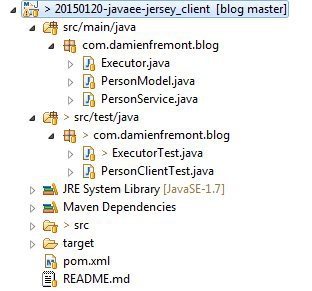
Voici comment créer un client HTTP REST en Java appelant un simple service CRUD. La solution se base sur le standard JavaEE JAX-RS avec comme implémentation Jersey-client pour le mapping et RESTEasy pour l’exécution, testé par JUnit et Jadler qui émule un server REST.
Environnement
Le client va appeler un service REST dont l’API est la suivante :
Source

pom.xml (config Maven)
<project xmlns="http://maven.apache.org/POM/4.0.0" xmlns:xsi="http://www.w3.org/2001/XMLSchema-instance"
xsi:schemaLocation="http://maven.apache.org/POM/4.0.0 http://maven.apache.org/xsd/maven-4.0.0.xsd">
<modelVersion>4.0.0</modelVersion>
<groupId>com.damienfremont.blog</groupId>
<artifactId>20150117-javaee-jersey_client</artifactId>
<version>0.0.1-SNAPSHOT</version>
<packaging>jar</packaging>
<properties>
<project.build.sourceEncoding>UTF-8</project.build.sourceEncoding>
<jdk.version>1.7</jdk.version>
<jersey.version>1.18.3</jersey.version>
<resteasy.version>2.3.1.GA</resteasy.version>
</properties>
<dependencies>
<!-- JERSEY CLIENT -->
<dependency>
<groupId>com.sun.jersey</groupId>
<artifactId>jersey-json</artifactId>
<version>${jersey.version}</version>
</dependency>
<dependency>
<groupId>com.sun.jersey</groupId>
<artifactId>jersey-client</artifactId>
<version>${jersey.version}</version>
</dependency>
<dependency>
<groupId>org.jboss.resteasy</groupId>
<artifactId>resteasy-jaxrs</artifactId>
<version>${resteasy.version}</version>
</dependency>
<dependency>
<groupId>org.jboss.resteasy</groupId>
<artifactId>resteasy-jettison-provider</artifactId>
<version>${resteasy.version}</version>
</dependency>
<!-- TEST -->
<dependency>
<groupId>junit</groupId>
<artifactId>junit</artifactId>
<version>4.9</version>
<scope>test</scope>
</dependency>
<dependency>
<groupId>org.easytesting</groupId>
<artifactId>fest-assert-core</artifactId>
<version>2.0M5</version>
<scope>test</scope>
</dependency>
<dependency>
<groupId>net.jadler</groupId>
<artifactId>jadler-all</artifactId>
<version>1.1.1</version>
<scope>test</scope>
</dependency>
<dependency>
<groupId>org.hamcrest</groupId>
<artifactId>hamcrest-core</artifactId>
<version>1.3</version>
</dependency>
</dependencies>
<build>
<plugins>
<plugin>
<groupId>org.apache.maven.plugins</groupId>
<artifactId>maven-compiler-plugin</artifactId>
<version>3.2</version>
<configuration>
<source>${jdk.version}</source>
<target>${jdk.version}</target>
</configuration>
</plugin>
</plugins>
</build>
</project>
PersonModel.java (un simple POJO, annoté en JAX-RS )
@XmlRootElement(name="person")
@JsonIgnoreProperties(ignoreUnknown = true)
public class PersonModel implements Serializable {
private static final long serialVersionUID = 6879685199191377814L;
private Integer id;
private String firstName;
private String lastName;
private String birthDate;
public Integer getId() {
return id;
}
public void setId(Integer id) {
this.id = id;
}
public String getFirstName() {
return firstName;
}
public void setFirstName(String firstName) {
this.firstName = firstName;
}
public String getLastName() {
return lastName;
}
public void setLastName(String lastName) {
this.lastName = lastName;
}
public String getBirthDate() {
return birthDate;
}
public void setBirthDate(String birthDate) {
this.birthDate = birthDate;
}
}
Personservice.java (une simple interface décrivant l’API, annotée en JAX-RS aussi)
@Path("persons")
public interface PersonService {
@GET
public void ping();
@POST
@Consumes(MediaType.APPLICATION_JSON)
public String createPerson(PersonModel newPerson);
@GET
@Path("id/{id}")
@Produces(MediaType.APPLICATION_JSON)
public PersonModel readPerson(@PathParam("id") Integer id);
@POST
@Path("id/{id}")
@Consumes(MediaType.APPLICATION_JSON)
public String updatePerson(@PathParam("id") Integer id, PersonModel actualPerson);
@DELETE
@Path("id/{id}")
public void deletePerson(@PathParam("id") Integer id);
}
Demo
Pour commencer, voici un test de connexion de notre client vers l’API en émulant un server HTTP REST avec Jadler.
PersonClientTest .java
public class PersonClientTest {
PersonService client;
@Before
public void setUp() {
// INIT MOCK
initJadler();
// INIT REST CLIENT
client = ProxyFactory.create(//
PersonService.class, //
"http://localhost:" + Jadler.port() + "/api");
}
@After
public void tearDown() {
closeJadler();
}
@Test
public void test_QUAND_create_person_ETANT_DONNE_new_ALORS_success() {
// ETANT DONNE
onRequest().havingMethodEqualTo("POST")
.havingPathEqualTo("/api/persons").respond()
.withBody("Location: /persons/id/6") //
.withEncoding(Charset.forName("UTF-8")) //
.withContentType("text/plain; charset=UTF-8") //
.withStatus(204);
PersonModel newPerson = new PersonModel();
newPerson.setFirstName("Luke");
newPerson.setLastName("Skylwalker");
newPerson.setBirthDate("19 BBY");
// QUAND
client.createPerson(newPerson);
// ALORS
// nothing to assert
}
@Test
public void test_QUAND_get_person_ETANT_DONNE_id_valid_ALORS_success() {
// ETANT DONNE
onRequest()
.havingMethodEqualTo("GET")
.havingPathEqualTo("/api/persons/id/1")
.respond()
.withBody(
"{person:{" //
+ "\"id\":\"1\","
+ "\"firstName\":\"Anakin\","
+ "\"lastName\":\"Skylwalker\","
+ "\"birthDate\":\"41.9 BBY\"" //
+ "}}") //
.withEncoding(Charset.forName("UTF-8")) //
.withContentType("application/json; charset=UTF-8") //
.withStatus(200);
Integer arg = 1;
// QUAND
PersonModel response = client.readPerson(arg);
// ALORS
assertThat(response).isNotNull();
assertThat(response.getId()).isNotNull();
assertThat(response.getFirstName()).isEqualTo("Anakin");
assertThat(response.getLastName()).isEqualTo("Skylwalker");
assertThat(response.getBirthDate()).isEqualTo("41.9 BBY");
}
@Test
public void test_QUAND_post_person_ETANT_DONNE_person_exists_ALORS_success() {
// ETANT DONNE
onRequest()
.havingMethodEqualTo("POST")
.havingPathEqualTo("/api/persons/id/1")
.respond()
.withStatus(200);
Integer arg = 1;
PersonModel newPerson = new PersonModel();
newPerson.setId(1);
newPerson.setFirstName("Anakin");
newPerson.setLastName("Skylwalker");
newPerson.setBirthDate("41.9 BBY");
// QUAND
client.updatePerson(arg, newPerson);
// ALORS
// nothing to assert
}
@Test
public void test_QUAND_delete_person_ETANT_DONNE_person_exists_ALORS_success() {
// ETANT DONNE
onRequest()
.havingMethodEqualTo("DELETE")
.havingPathEqualTo("/api/persons/id/1")
.respond()
.withStatus(200);
Integer arg = 1;
// QUAND
client.deletePerson(arg);
// ALORS
// nothing to assert
}
}

C’est donc un test d’intégration du client que l’on peut lancer comme un simple test JUnit.
Amélioration
Il est recommandé de configurer les TimeOuts sur votre client JAX-RS, pour éviter de bloquer votre application (ou un de vos threads si c’est un server).
Executor.java
public class Executor extends ApacheHttpClient4Executor
{
private static final int connectionTimeoutMillis = 2000;
private static final int socketTimeoutMillis = 3000;
public Executor()
{
super( initHttpClient() );
}
private static DefaultHttpClient initHttpClient()
{
DefaultHttpClient httpClient = new DefaultHttpClient();
HttpParams params = httpClient.getParams();
HttpConnectionParams.setConnectionTimeout( params, connectionTimeoutMillis );
HttpConnectionParams.setSoTimeout( params, socketTimeoutMillis );
return httpClient;
}
}
Qui peut aussi se tester avec Jadler.
ExecutorTest.java
public class ExecutorTest {
PersonService client;
@Before
public void setUp() {
// INIT MOCK
initJadler();
// INIT REST CLIENT
client = ProxyFactory.create(//
PersonService.class, //
"http://localhost:" + Jadler.port() + "/api", new Executor());
}
@After
public void tearDown() {
closeJadler();
}
@Test
public void test_QUAND_ping_ETANT_DONNE_system_ok_ALORS_success() {
// ETANT DONNE
onRequest().havingMethodEqualTo("GET")
.havingPathEqualTo("/api/persons").respond()
.withDelay(1, SECONDS);
// QUAND
client.ping();
}
@Test
public void test_QUAND_ping_ETANT_DONNE_system_lag_ALORS_timeout() {
// ETANT DONNE
onRequest().havingMethodEqualTo("GET")
.havingPathEqualTo("/api/persons").respond()
.withDelay(50, SECONDS);
// QUAND
try {
client.ping();
fail("Expected Exception!");
} catch (Exception e) {
// ALORS
assertThat(e.getMessage()).contains("Read timed out");
}
}
}

Conclusion
Pour une fois, pas de réelle contre-partie :
- Le client est facile à coder car il n’y a même pas d’implémentation.
- Les tests sont auto-documentés et automatisé (indépendants, répétables, non-régression, etc).
Le plus intéressant étant que la maintenance en est grandement simplifié …le source ne contenant que du code “métier” (pas de code boilerplate) et le comportement est testé.
Source code
https://github.com/DamienFremont/damienfremont.com-blog-labs/tree/master/20150120-javaee-jersey_client https://github.com/DamienFremont/damienfremont.com-blog-labs/tree/master/20150120-javaee-jersey_client
References
http://www.mkyong.com/tutorials/jax-rs-tutorials/ http://www.mkyong.com/tutorials/jax-rs-tutorials/
http://www.mastertheboss.com/jboss-frameworks/resteasy/resteasy-tutorial http://www.mastertheboss.com/jboss-frameworks/resteasy/resteasy-tutorial











